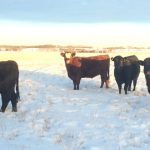
Soybean acres may soon stabilize in Manitoba
Volatile yields, acres and weather have kept soy on a roller-coaster since 2017

Prairie forecast: Dry and mild west, seasonal east
Issued Feb. 14, covering Feb 14 to 21, 2024

Klassen: Feeder market continues to climb
Canadian values appear to be one week behind the U.S. market

Prairie wheat weekly outlook: Prices down, especially for durum
Weaker Canadian dollar lends support, K.C., Chicago and Minneapolis wheat put pressure on prices

Prairie forecast: Stormy start in the east, slightly cooler west
Issued Feb. 7, covering Feb. 7 to 14, 2024

Klassen: Canadian feeder market jumps on USDA data
The U.S. cattle herd reached lowest head count since 1950s, trade anticipates heifer retention

Prairie forecast: A little more heat, then slow cool down
Issued Jan. 31, 2024. Covers Jan. 31 to Feb. 7

Klassen: Positive fed outlook buoys feeder market
Market telling producers to own lighter cattle sooner rather than later

Canadian potato output rises in 2023
Alberta vaults to first place in provincial potato production

Prairie forecast: Warm weather returns
Issued Jan. 24, 2024, covering Jan. 24 to 31


